Exploring the Animals of New Zealand
Want to see New Zealand wildlife on your next vacation? New Zealand is filled with unique animals—although they are not always easy to spot! From the fascinating kiwi bird to the world’s smallest penguins, New Zealand is home to many species of animals. Most of the species are not native to New Zealand; the only native mammals are bats and marine mammals.
See if you can spot this unique wildlife in New Zealand:
Kiwi
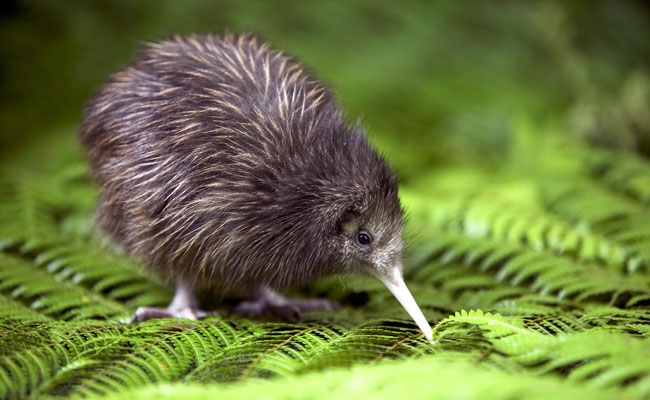
Kiwi’s are a beloved icon in New Zealand. Image: Rotorua Tourism
The Kiwi bird is so iconic that New Zealanders are known as Kiwis. These cute, fluffy birds are only found in New Zealand. They’re quite shy and only come out at night, so it’s rare to spot them in the wild.
Kiwi Fun Facts:
- Kiwi birds are nocturnal
- Kiwi eggs take up 20% of their body miss
- Kiwi birds are among the few species that mate for life; a kiwi relationship has been known to last for over 20 years
- Kiwi birds have nostrils at the end of their beaks and have a great sense of smell, unlike most birds
- Kiwi birds cannot fly and their feathers are more hair-like in texture
Where to See Them:
It’s difficult to see Kiwi birds in the wild, but you can see them at a New Zealand wildlife sanctuary. We recommend the Kiwi Birdlife Park in Queenstown or Rainbow Springs Nature Park in Rotorua.
Sheep
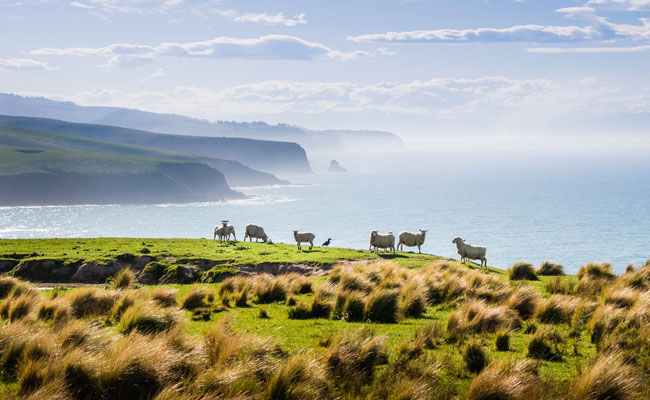
Sheep grazing in the beautiful seaside meadows of New Zealand. Image: Annandale
Sheep are not technically “wildlife,” but there sure are a lot of them—in New Zealand, there are about 10 sheep for every person! You’ll be sure to see plenty of them as you drive through lush, rolling farmland on the North and South Islands.
New Zealand Sheep Fun Facts:
- New Zealand’s first sheep were set ashore by Captain Cook in 1773
- Sheep have a field vision of around 300 degrees, which means they can see behind themselves without having to turn their head!
- Sheep are raised for four main products: lamb, mutton, wool, and milk
- The first shipment of frozen lamb and mutton sailed to London from Port Chalmers, New Zealand on The Dunedin in 1882
Where to See Them:
As we mentioned above, you’ll certainly see plenty of sheep as you’re driving from one place to the next. But if you really love sheep and want an authentic New Zealand experience, you can stay at a working sheep farm like Annandale on the South Island (complete with luxurious villa accommodations). Or take the kids to the Agrodome in Rotorua to see live sheep herding and shearing demonstrations.
Yellow-Eyed Penguin
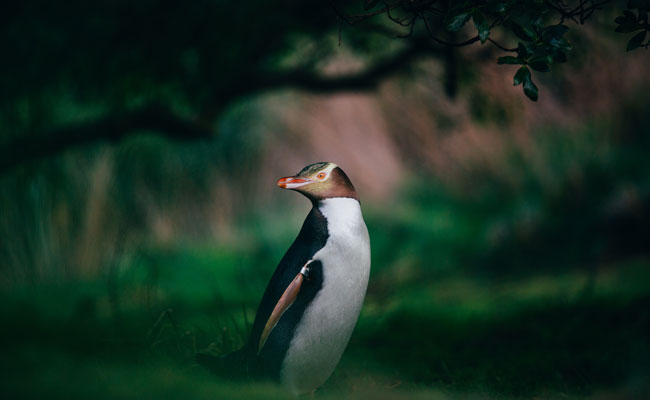
Seeing the yellow-eyed penguin is a must for birders. Image: Tourism New Zealand
Yellow-eyed penguins are among the largest penguins in the world, with adults reaching up to 2.5 feet tall, and can be found on the coasts of New Zealand.
Yellow-Eyed Penguin Fun Facts:
- Yellow-eyed penguins lay two eggs and parents typically raise both chicks
- As their name implies, yellow-eyed penguins have pale yellow eyes and their head features a bright yellow stripe extending from their eyes around the back of their head
- Yellow-eyed penguins usually nest in forests and scrub that line the New Zealand coast
- The yellow-eyed penguin is now the rarest penguin in the world due to deforestation and predators
Where to See Them:
Yellow-eyed penguins can be found on the Otago Peninsula, including the city of Dunedin. You may be lucky enough to see them waddling along the beaches on your own, but we recommend taking a wildlife tour from Dunedin if you really want to see the penguins!
Dusky Dolphin
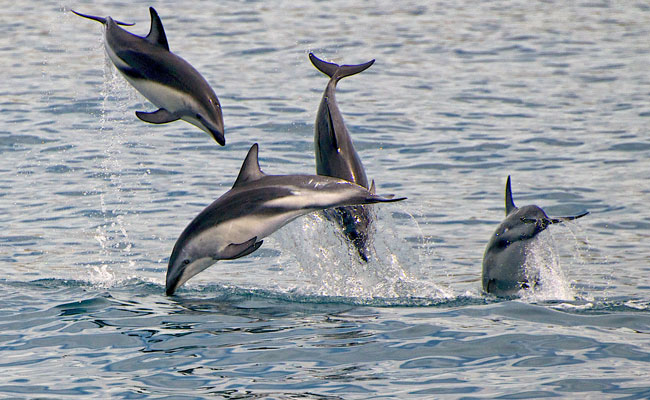
Dusky dolphins are often found among other species of whales and dolphins. Image: Encounter Kaikoura
Most people don’t think of dolphins when they think of New Zealand wildlife, but there are plenty along the coasts of this small island country. Dusky dolphins are super acrobatic and can be seen leaping out of the water and tumbling in the air. They’re very social and speedy swimmers. Clicks, squeaks, and whistles can be heard almost 2 miles away when they communicate out of the water.
Dusky Dolphin Fun Facts:
- Dusky dolphins can grow up to 7 feet in length
- The dorsal side of the dusky dolphin is dark grey with two cream lines between the fin and tail
- Dusky dolphins normally swim in pods of 10 to 20 animals
- Dusky dolphins swim close to the coast, which means a high probability of viewing them in their natural habitat
Where to See Them:
You can go swimming with dusky dolphins on a tour from Kaikoura. Be sure to do your research and choose an ethical tour operator! We have a great partner in Kaikoura that ensures a fun experience for both humans and animals.
Royal Albatross
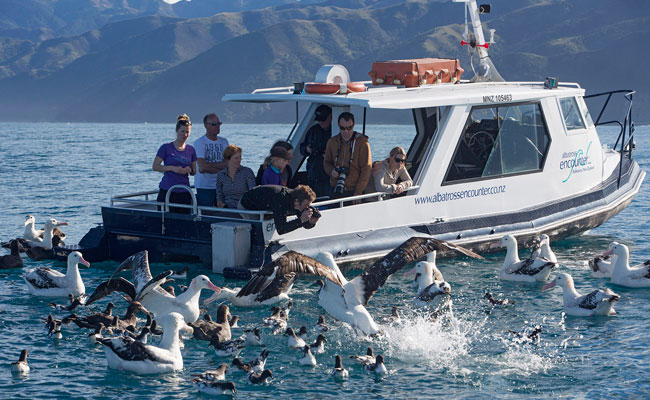
Albatrosses can live up 40 years in the wild. Image: Encounter Kaikoura
Did you know that albatross spend most of their life at sea, sometimes flying up to an estimated 118,060 miles per year? They have a huge wingspan, some reaching up to 10 ten feet across! They only spend time on land when they return to breed and raise their young. Albatross are also one of the few species that mate for life.
Royal Albatross Fun Facts:
- They can live to be 60 years old
- They have the largest wingspan of any living bird
- They have a surprisingly good sense of smell, but not as strong as a Kiwi
Where to See Them:
There’s only one place in the world where royal albatross breed on the mainland, and it just so happens to be about 20 minutes’ drive from Dunedin!
Little Blue Penguin
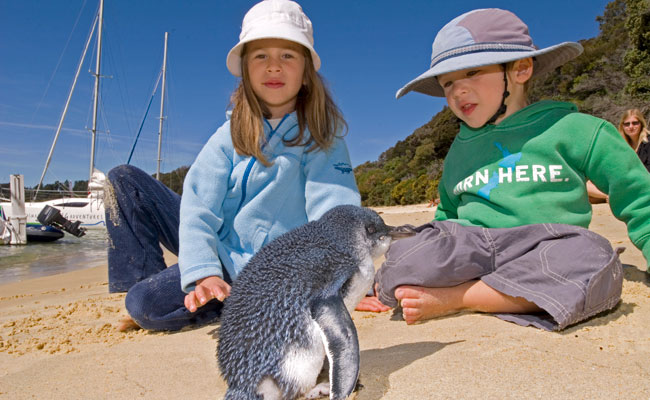
Get up close with extremely cute wild little blue penguins. Image: Tourism New Zealand
Little blue penguins are the smallest penguins in the world at just 13-17 inches tall. They usually nest in burrows, rock crevices, caves, or even under buildings. They only come ashore at dusk, which makes them easy to spot along the shore.
Little Penguin Fun Facts:
- Blue penguins weigh between 2-2.5 lbs
- Their average lifespan is 6.5 years, but there are some records of them living up to 20
- Little penguins are often in long-term relationships
- Chicks will often times return to within a few miles of where they were raised, and once they settle in that area they never move away
Where to See Them:
Like many of the other unique birds on this list, little blue penguins can be seen on a wildlife tour from Dunedin. There’s also a quirky little town called Oamaru, about 1.5 hours from Dunedin, that’s famous for its little blue penguin colony.
Ready to begin planning your own vacation to see New Zealand’s wonderful wildlife? Browse our New Zealand travel packages, or give us a call at 888-229-0082 to start planning the adventure of a lifetime!
Hector’s Dolphin
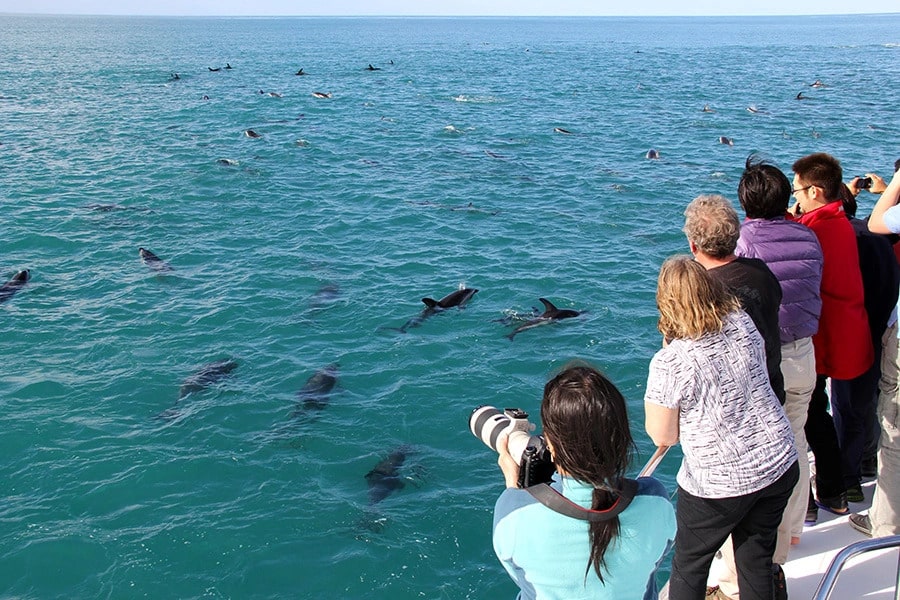
People watching dolphins Image: Tourism New Zealand
Hector’s dolphins are the world’s smallest marine dolphins—and among the rarest. Known for their rounded dorsal fins and playful nature, these native animals are found only in the waters surrounding Aotearoa New Zealand, particularly along the South Island’s east coast. These dolphins are easily recognizable and a joy to watch in the wild.
Hector’s Dolphin Fun Facts:
- Adults grow to about 4.5 feet long and weigh around 110 pounds
- Their dorsal fins are rounded, often compared to Mickey Mouse ears
- They live in small pods and tend to stay close to shore
- A subspecies, Maui’s dolphin, is critically endangered
Where to See Them:
The best place to see Hector’s dolphins is in Akaroa, located on New Zealand’s South Island. Several eco-friendly tours operate from this charming French-influenced village, offering an unforgettable chance to view these rare marine mammals in their natural habitat. As always, choose a certified responsible tour operator to ensure the safety of the dolphins and support conservation efforts.
Conservation Efforts for New Zealand’s Wildlife
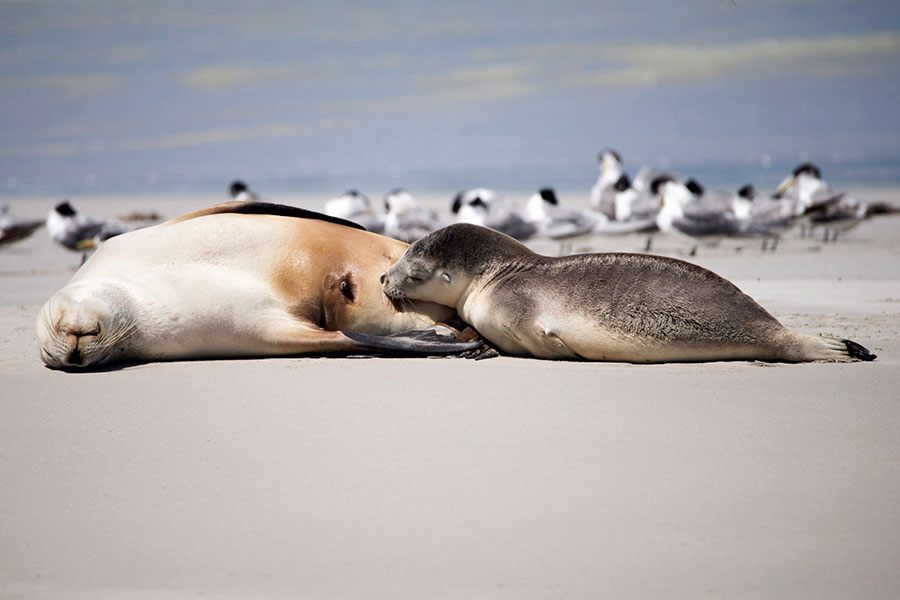
Sea Lion Nursing Pup Seal Image: Tourism New Zealand
New Zealand faces unique conservation challenges. Habitat loss, climate change, and invasive species have threatened native animals for generations. Introduced predators such as stoats, rats, and possums continue to endanger ground-dwelling birds like the kiwi and the rare kakapo. Conservation projects in New Zealand are taking bold steps to reverse these threats. Sanctuaries like Zealandia and predator-free offshore islands are helping restore balance to delicate ecosystems.
The integration of Māori culture plays a pivotal role in these efforts. Māori conservation values, known as kaitiakitanga, emphasize guardianship of the land and its creatures. In partnership with government and private organizations, local iwi help monitor endangered species, protect sacred habitats, and reintroduce native birds to restored forests.
Exploring New Zealand’s Diverse Ecosystems
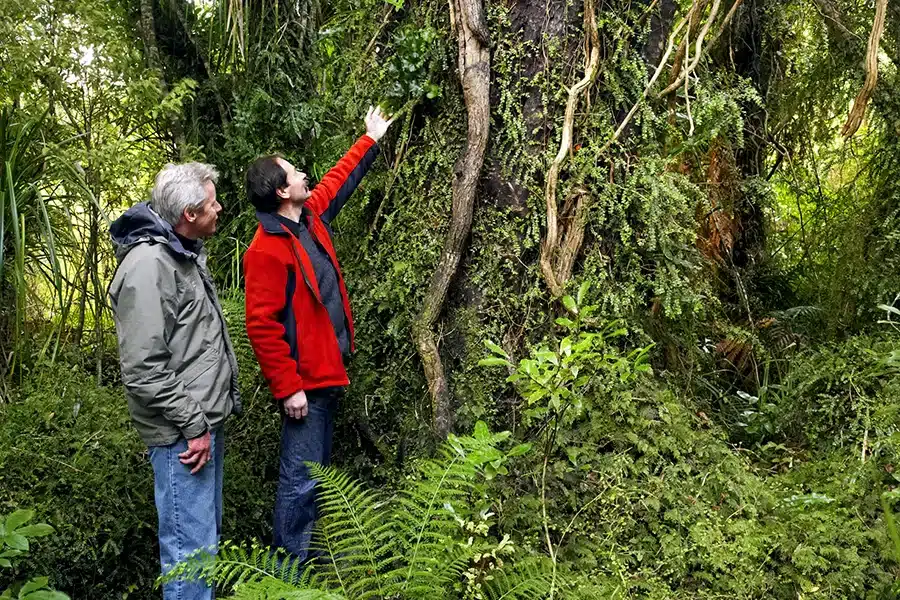
Explore ancient rainforest trails near Lake Moeraki in New Zealand.
From ancient New Zealand forests to windswept coastlines, the country’s biodiversity is sustained by richly varied ecosystems. Forests provide sanctuary for flightless birds and insects, wetlands protect amphibians and wading birds, and marine reserves teem with coral, fish, and marine mammals. These ecosystems support hundreds of native species, including many endemic to this part of the world.
Marine reserves like Poor Knights Islands and Goat Island are critical in preserving ocean biodiversity. These protected areas are havens for unique marine life like the dusky dolphins and the elusive New Zealand sea lion. For nature lovers, these environments offer unforgettable opportunities to see species in their natural habitats, without disturbing them.
The Impact of Invasive Species
New Zealand’s native wildlife evolved without natural predators. Today, invasive species are the greatest threat to animals of New Zealand. Possums destroy vegetation and eat bird eggs. Stoats prey on native birds. Even pets, if not properly managed, can pose dangers to native wildlife.
The Department of Conservation and community groups have launched large-scale pest control and trapping programs. These efforts are essential in saving endangered species in New Zealand, including the royal albatross and the beloved kiwi bird.
Wildlife Watching and Ecotourism in New Zealand
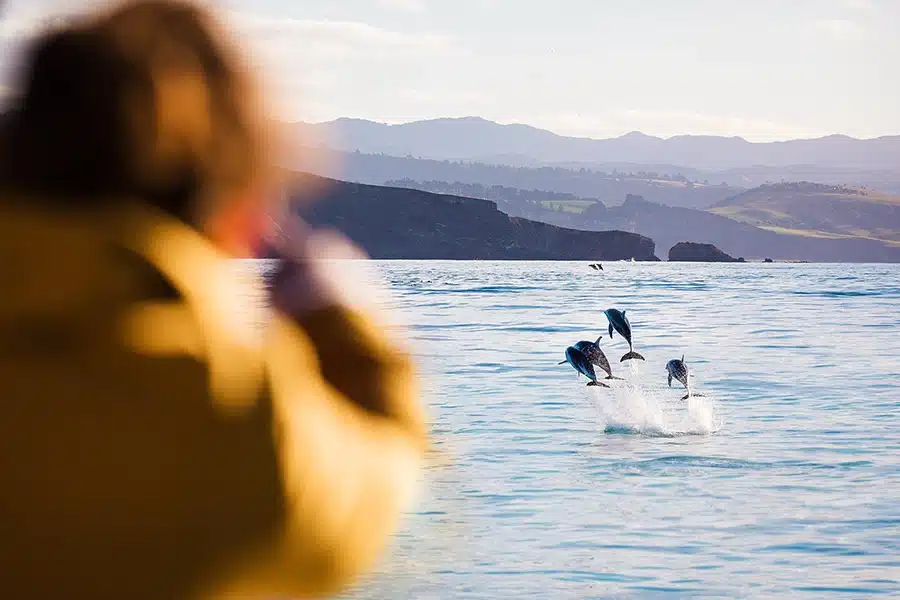
Ecotourism offers travelers a way to experience native wildlife while supporting conservation. Whether birdwatching on the Otago Peninsula, visiting Taiaroa Head to view the royal albatross, or swimming with dolphins in Kaikoura on New Zealand’s South Island, your adventures can directly contribute to conservation.
Responsible travel means following ethical guidelines: observe wildlife from a distance, stick to marked trails, and travel with certified eco-operators.
The Role of Marine Life in New Zealand’s Biodiversity
New Zealand’s waters are home to rare marine species like the Māui’s dolphin, dusky dolphins, and the New Zealand sea lion. Marine reserves, such as Goat Island, protect these fragile ecosystems and support vital conservation projects. However, marine biodiversity faces threats like overfishing and climate change. Exploring a New Zealand marine reserve offers a glimpse into these vibrant ecosystems while supporting wildlife conservation and the preservation of marine life in Aotearoa New Zealand.
Understanding the Behavior of New Zealand’s Native Animals
New Zealand’s isolation shaped unique animal behavior, especially among native birds like the nocturnal kiwi bird. Species such as the kakapo and New Zealand sea lion display rare adaptations studied by conservationists in the wild. Researching behavior helps protect native wildlife, ensuring ecosystems stay balanced. Whether observing a bird’s mating call or a penguin’s nesting habits, every moment reflects the remarkable evolution of native species in New Zealand’s South Island and beyond.